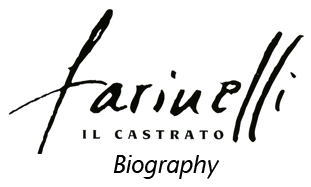
Türkçe için tıklayınız... (For Turkish)
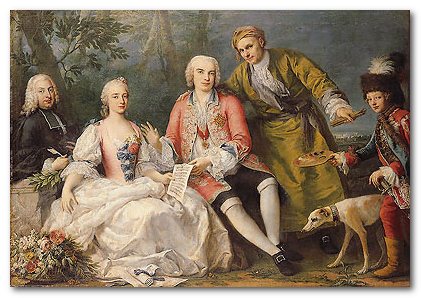
Who is Farinelli?
Farinelli (January 24, 1705 September 16, 1782), whose real name was Carlo Broschi, was one of the most famous Italian soprano castrato singers of the 18th century.
Early years
Broschi was born in Andria (now in the Italian region of Puglia) into a family of musicians. His father Salvatore was also governor of Maratea and Cisternino from 1706 to 1709. Broschi was castrated as a boy to preserve his young voice into adulthood.
As was often the case, an excuse had to be found for this always illegal operation, and in Carlo's case it was said to have been necessitated by a fall from a horse.
In 1711, Carlo's family moved to Naples, where the young singer later studied with the famous composer and singing-teacher Nicola Porpora. He made his public debut in 1720 in Porpora's Angelica e Medoro, and soon became famous throughout Italy as il ragazzo ("the boy"; the origin of his stage name of Farinelli is unclear, though a possible explanation is that three rich Neapolitan music-loving brothers by name Farina sponsored Carlo in his studies).
In 1722 he made his first appearance at Rome in his master's Eumene and was received with enormous enthusiasm. From about this time there dates an almost legendary story that he had to perform an aria with trumpet obbligato, which evolved into a contest between singer and trumpeter. The latter thought he had achieved prodigies of technique and ornamentation, only for Farinelli to surpass him so much that he "was at last silenced only by the acclamations of the audience" (to quote the music historian Charles Burney this account cannot be verified one way or the other, since no surviving work which Farinelli is known to have performed at this time contains an aria for soprano with trumpet obbligato). In common with many young castrati, Farinelli, in the early stages of his career frequently sang women's roles, including the title-role in Porpora's Adelaide.
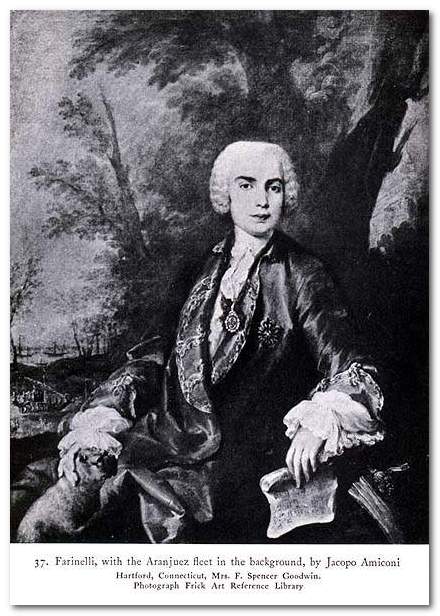 Career
in Europe
Career
in Europe
In 1724, Farinelli first appeared at Vienna, spending the following
season in Naples.
In 1726, he also visited Parma and Milan, where Johann Joachim Quantz
heard him and commented: "Farinelli had a penetrating, full, rich,
bright and well-modulated soprano voice, with a range at that time from
the A below middle C to the D two octaves above middle C. ... His
intonation was pure, his trill beautiful, his breath control
extraordinary and his throat very agile, so that he performed the widest
intervals quickly and with the greatest ease and certainty. Passagework
and all kinds of melismas were of no difficulty to him. In the invention
of free ornamentation in adagio he was very fertile."
Farinelli sang at Bologna in 1727. There he met and acknowledged himself
vanquished by the singer Antonio Bernacchi (twenty years Farinelli's
senior), to whose instruction in finer points of technique he was much
indebted.
With ever-increasing success and fame, Farinelli appeared in nearly all
the great cities of Italy. Handel was keen to engage him for his company
in London and while in Venice in January 1730, tried unsuccessfully to
meet him
Farinelli, by Corrado Giaquinto c1755
In 1731, Farinelli visited Vienna for a third time. There
he was received by the Holy Roman Emperor, Charles VI, on whose advice,
according to the singer's first biographer, Giovenale Sacchi, he
modified his style, expanding his affective repertoire to include pathos
and simplicity alongside bravura. After further seasons in Italy, and
another visit to Vienna, during which he sang in oratorios in the
Imperial chapel, Farinelli came to London in 1734. He had been engaged
by "The Opera of the Nobility", a company, supported by Frederick,
Prince of Wales in opposition to Handel, that had Porpora as its
composer and Senesino as principal singer. Farinelli's first appearance,
at the theatre in Lincoln's Inn Fields, was in Artaserse, a pasticcio
opera for which his brother Riccardo Broschi had composed some of the
music. Though his success was instantaneous and enormous, neither the
Nobility Opera nor Handel's company was able to sustain the public's
interest. Farinelli, nonetheless, was still under contract in London in
the summer of 1737 when he received a summons, via Sir Thomas
Fitzgerald, Secretary of the Spanish Embassy there, to visit the Spanish
court.
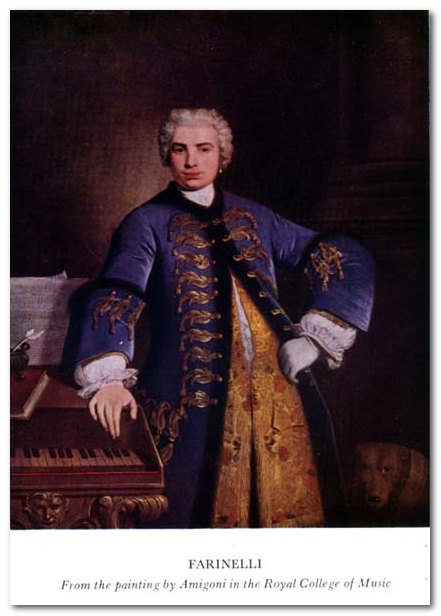
Farinelli in London
In London the previous year, Senesino, a singer who had
been a part of Handel's "Second Academy" which performed at the King's
Theatre, Haymarket, quarrelled with Handel and established a rival
company, "Opera of the Nobility", operating from a theatre in Lincoln's
Inn Fields. This company had Porpora as composer and Senesino as
principal singer, but had not been a success during its first season of
1733-34. Farinelli, Porpora's most famous pupil, joined the company and
made it financially solvent.
He first appeared in Artaserse, a pasticcio with music by his brother
Riccardo and by Johann Adolph Hasse. He sang the memorable arias "Per
questo dolce amplesso" (music by Hasse) and "Son qual nave" (music by
Broschi), while Senesino sang "Pallido il sole" (music by Hasse). Of
"Per questo dolce amplesso", Charles Burney reports: "Senesino had the
part of a furious tyrant, and Farinelli that of an unfortunate hero in
chains; but in the course of the first air, the captive so softened the
heart of the tyrant, that Senesino, forgetting his stage-character, ran
to Farinelli and embraced him in his own." "Son qual nave", on the other
hand, was composed by Riccardo Broschi as a special showpiece for his
brother's virtuosic skills. Burney described it thus: "The first note he
sung was taken with such delicacy, swelled by minute degrees to such an
amazing volume, and afterwards diminished in the same manner to a mere
point, that it was applauded for full five minutes. After this he set
off with such brilliancy and rapidity of execution, that it was
difficult for the violins of those days to keep pace with him."
Both the cognoscenti and the public adored him. The librettist Paolo
Rolli, a close friend and supporter of Senesino, commented: "Farinelli
has surprised me so much that I feel as though I had hitherto heard only
a small part of the human voice, and now have heard it all. He has
besides, the most amiable and polite manners ...". Some fans were more
unrestrained: one titled lady was so carried away that, from a theatre
box, she famously exclaimed: "One God, one Farinelli!" and was
immortalised in a detail of Plate II of William Hogarth's "The Rake's
Progress" (she may also appear in Plate IV of his series "Marriage à la
mode" of 1745).
Though Farinelli's success was enormous, neither the Nobility Opera nor
Handel's company was able to sustain the public's interest, which waned
rapidly. Though his official salary was £1500 for a season, gifts from
admirers probably increased this to something more like £5000, an
enormous sum at the time. Farinelli was by no means the only singer to
receive such large amounts, which were unsustainable in the long term.
As one contemporary observer remarked: "within these two years we have
seen even Farinelli sing to an audience of five-and-thirty pounds".
Nonetheless, he was still under contract in London in the summer of 1737
when he received a summons, via Sir Thomas Fitzgerald, Secretary of the
Spanish Embassy there, to visit the Spanish court.
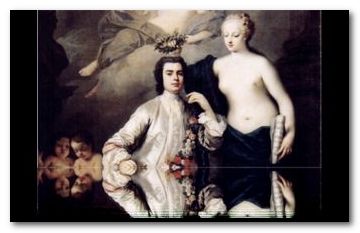 At
the court of Spain
At
the court of Spain
Farinelli, by Jacopo Amigoni c1750-52
Apparently intending to make only a brief visit to the
Continent, Farinelli called at Paris on his way to Madrid, singing at
Versailles to King Louis XV on 9 July. Louis XV gave him his portrait
set in diamonds, and 500 Louis d'or. On 15 July he left for Spain,
arriving about a month later. Elisabetta Farnese, the Queen, had come to
believe that Farinelli's voice might be able to cure the severe
depression of her husband, King Philip V (contemporary physicians, such
as the Queen's doctor Giuseppi Cervi, believed in music therapy).
On 25 August 1737, Farinelli was named Chamber Musician to the king, and
criado familiar (this translates approximately as "honorary member of
the Royal Family"). He never sang again in public.
Farinelli became a royal favourite and very influential at court. For
the remaining nine years of Philip's life, Farinelli gave nightly
private concerts to the royal couple. He also sang for other members of
the royal family and organised private performances by them, and by
professional musicians in the royal palaces. In 1738 he arranged for an
entire Italian opera company to visit Madrid, beginning a fashion for
opera seria in the Spanish capital. The Coliseo of the royal palace of
Buen Retiro was remodelled, and became Madrid's only opera house.
On the accession of Philip's son, Ferdinand VI, Farinelli's influence
became even greater. Ferdinand was a keen musician, and his wife,
Barbara of Portugal, nearly a musical fanatic (in 1728 she had appointed
Domenico Scarlatti, as her harpsichord teacher; the musicologist Ralph
Kirkpatrick acknowledges Farinelli's correspondence as providing "most
of the direct information about Scarlatti that has transmitted itself to
our day"). The relationship between singer and monarchs was personally
close: he and the queen sang duets together, and the king accompanied
him on the harpsichord. Farinelli took charge of all spectacles and
court entertainments. He was himself also officially received into the
ranks of the nobility, being made a Knight of the Order of Calatrava in
1750, an honour of which he was enormously proud. Although much courted
by diplomats, Farinelli seems to have managed to keep out of politics.
Retirement and death
In 1759, Ferdinand was succeeded by his half-brother
Charles III, who was no lover of music. Charles was the son of
Elisabetta Farnese, who had never forgiven Farinelli for his decision to
remain at court after Philip V's death, rather than following her into
internal exile. It was clear that Farinelli would now have to leave
Spain, though he was allowed a generous state pension. He retired to
Bologna, where in 1732 he had acquired a property and citizenship.
Though rich and still famous, much feted by local notables and visited
by such notable figures as Burney, Mozart and Casanova, he was lonely in
his old age, having outlived many of his friends and former colleagues.
One distinguished friend of his latter years was the music historian,
Giovanni Battista (known as "Padre") Martini. He also continued his
correspondence with Metastasio, court poet at Vienna, dying a few months
after him. In his will, Farinelli asked that he be buried in the mantle
of the order of Calatrava, and was interred in the cemetery of the
Capuchin monastery of Santa Croce in Bologna. His estate included gifts
from royalty, a large collection of paintings including works by
Velázquez, Murillo and Jusepe de Ribera, as well as portraits of his
royal patrons, and several of himself, one by his friend Jacopo Amigoni.
He also had a collection of keyboard instruments in which he took great
delight, especially a piano made at Florence in 1730 (called in the will
cembalo a martellini), and violins by Stradivarius and Amati.
His original place of burial was destroyed during the Napoleonic wars,
and in 1810 Farinelli's great-niece Maria Carlotta Pisani had his
remains transferred to the cemetery of La Certosa in Bologna.
Farinelli's immediate heir, his nephew Matteo Pisani, sold Farinelli's
house in 1798. (It later became the headquarters of a sugar factory, and
was demolished in 1949, having been much damaged by bombardment during
the second World War.) Maria Carlotta bequeathed many of Farinelli's
letters to Bologna's University Library and was buried in the same grave
as Farinelli in 1850..
Farinelli's other musical activities
Farinelli not only sang, but like most musicians of his time, was a competent harpsichordist. In old age, he learned to play the viola d'amore. He occasionally composed, writing a cantata of farewell to London (entitled Ossequiosissimo ringraziamento, for which he also wrote the text), and a few songs and arias, including one dedicated to Ferdinand VI.
Farinelli Study Centre
Farinelli lived in Bologna from 1761 until his death. The
Farinelli Study Centre (Centro Studi Farinelli) was opened in Bologna in
1998. Major events and achievements include:
The restoration of Farinelli's grave in the Certosa of Bologna (2000)
An historical exhibition Farinelli a Bologna (2001 and 2005)
The inauguration of a City Park in the name of Farinelli, near the site
where the singer lived in Bologna (2002)
An international symposium Il Farinelli e gli evirati cantori on the
occasion of Farinelli's 300th anniversary of his birth (2005)
An official publication Il fantasma del Farinelli (2005)
The disinterment of Farinelli at the Certosa of Bologna (2006)
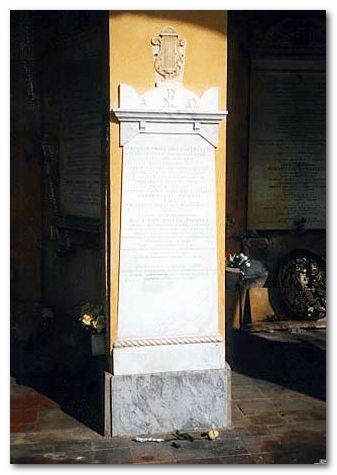 Disinterment
Disinterment
Farinelli's remains were disinterred from the Certosa
cemetery on 12 July 2006. The stacking of the bones had degraded the
condition of Farinelli's remains, but these included his jawbone,
several teeth, parts of his skull and almost all of the major bones.
Florentine antiquarian Alberto Bruschi and Luigi Verdi, Secretary of the
Farinelli Study Centre, co-ordinator and general manager of the project,
promoted the exhumation. The next day Carlo Vitali of the Farinelli
Study Centre stated that the major bones were "long and sturdy, which
would correspond with Farinelli's official portraits, as well as the
castrati's reputation for being unusually tall." Maria Giovanna
Belcastro of the Anthropology Institute of Bologna University, Gino
Fornaciari, paleoanthropologist of the University of Pisa and engineer
David Howard of York University are charged with deriving such new data
on Farinelli and his lifestyle, habits and possible diseases, as well as
the physiology of a castrato, as can be retrieved from these remains.
Their research methods will include X-rays, CAT scans and DNA sampling.
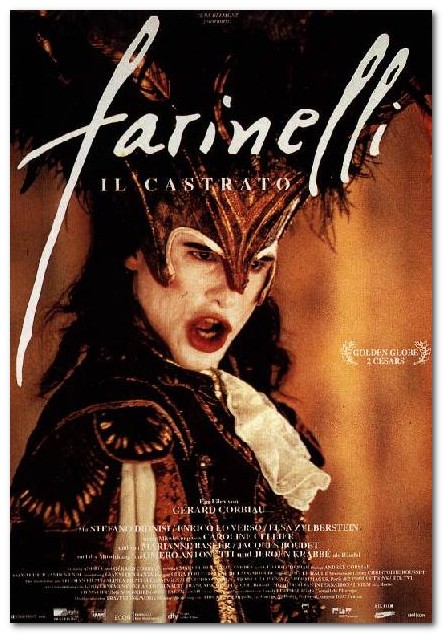
"Reincarnations" of Farinelli
A film, Farinelli, directed by Gérard Corbiau, was made
about Farinelli's life in 1994. This takes considerable dramatic licence
with history, emphasising the importance of Farinelli's brother and
reducing Porpora's role, while Handel becomes an antagonist; the
singer's time in Spain is ignored almost entirely. Farinelli's supposed
sexual exploits are a major element of the film's plot. Though
cinematically effective, they have no basis in reality.
The film is not the first dramatic work to take Farinelli's life as its
source material. He appears as a character in the opera La Part du
Diable, composed by Daniel Auber to a libretto by Eugène Scribe, and has
the title-role in an opera by the English composer John Barnett, first
performed at Drury Lane in 1839, where his part is, oddly, written for a
tenor (this work is itself an adaptation of the anonymous Farinelli, ou
le Bouffe du Roi, premiered in Paris in 1835). More recent operas
include Matteo d'Amico's Farinelli, la voce perduta (1996) and Farinelli,
oder die Macht des Gesanges by Siegfried Matthus (1998).
References
Ellen T. Harris. "Farinelli", Grove Music Online, ed. L.
Macy (accessed 07 November 2007), grovemusic.com (subscription access).
Heriot, A: The castrati in Opera (London, 1956), pp
95110
Cappelletto, S: La voce perduta (Turin, 1995); the most
recent biography of the singer
Pérez Samper, M A: Isabel de Farnesio (Barcelona, 2003),
pp 387397
Farinelli (British Journal for Eighteenth-Century
Studies; vol 28, no 3 (Oxford, 2005); the most recent collection of
articles about the singer
Crow, C: Orchestration
Or Castration (History Today,
September 2006; vol 56, no 9, pp 45)
Links